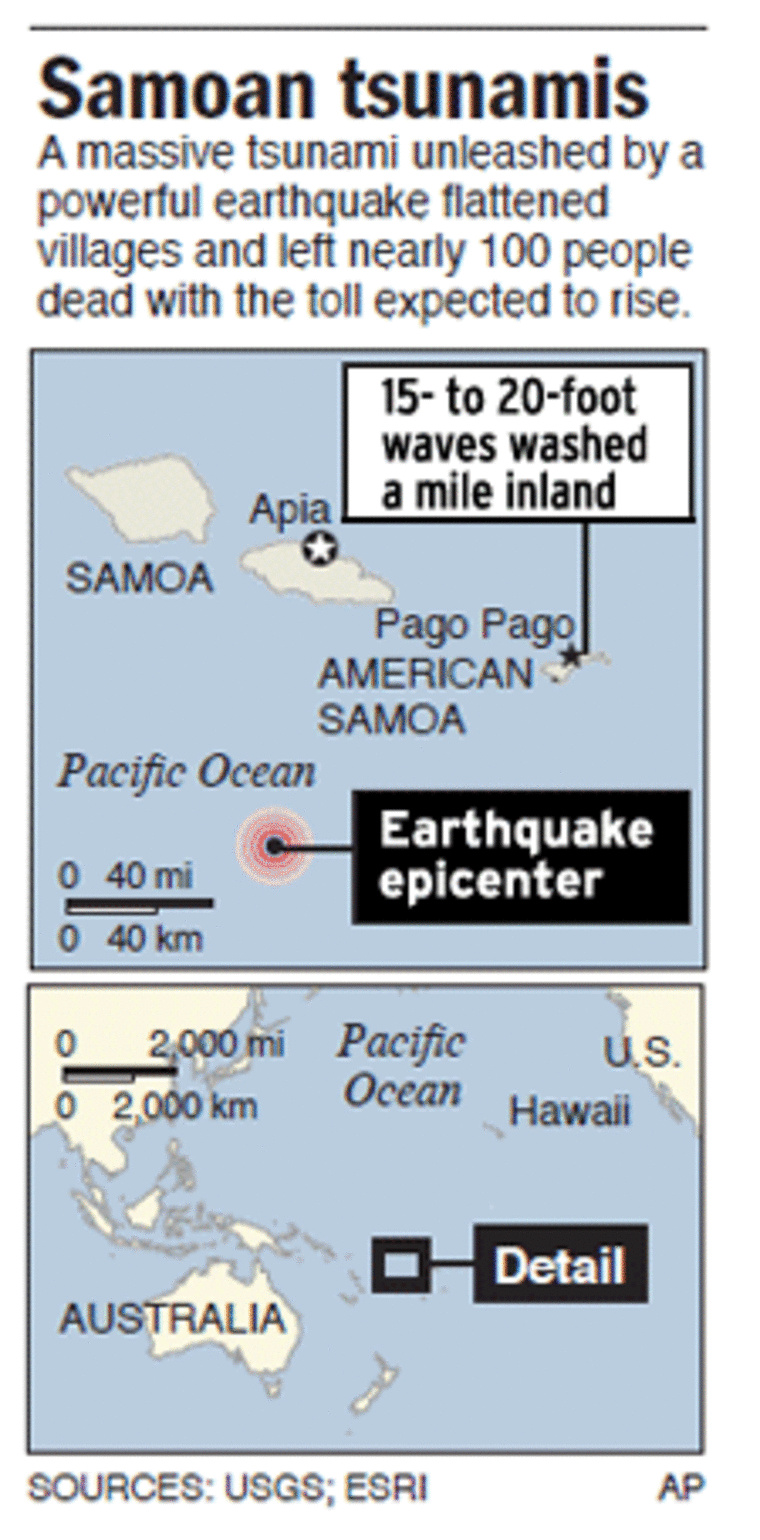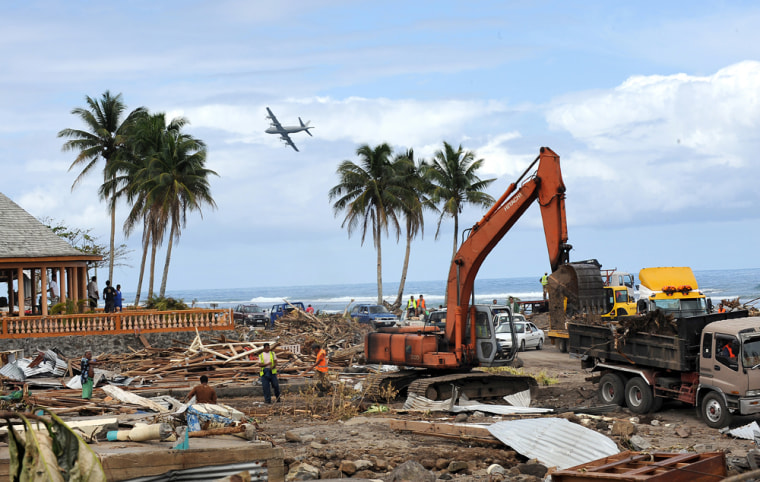Samoans searched flattened homes and debris-filled swamps Thursday as more military ships and planes began arriving on the disaster-stricken Pacific islands after an earthquake and tsunami that killed at least 150 people.
The day after the disaster struck, officials were expecting the death toll to rise as more areas were searched — a process that could take several weeks.
A Navy frigate carrying two helicopters and medical supplies arrived late Wednesday in American Samoa, and the Air Force dispatched two cargo planes. Australian officials said they will send an air force plane carrying 20 tons of humanitarian aid.
"This is a devastating earthquake and a devastating tsunami," Federal Emergency Management Agency coordinating officer Kenneth Tingman told reporters in American Samoa. "We know that power is paramount but we are also doing life saving and life sustaining efforts."
A magnitude 8.0 quake struck off Samoa at 6:48 a.m. local time (1:48 p.m. EDT; 1748 GMT) Tuesday. The islands soon were engulfed by four tsunami waves 15 to 20 feet high that reached up to a mile inland.
The Samoas lie about halfway between New Zealand and Hawaii, just east of the international date line.
‘It was like a monster’
Samoan Prime Minister Tuilaepa Sailele's own village of Lesa was washed away — like many others on Samoa and nearby American Samoa and Tonga. He inspected Wednesday the southeast coast of the main Samoan island of Upolu, the most heavily hit area. He described seeing "complete" devastation. Dazed survivors told of being trapped underwater or flung inland by the tsunami.
"In some villages absolutely no house was standing. All that was achieved within 10 minutes by the very powerful tsunami," he said.
"To me it was like a monster — just black water coming to you. It wasn't a wave that breaks, it was a full force of water coming straight," said Luana Tavale, an American Samoa government employee.
Tuilaepa said the death toll in Samoa was 110, mostly elderly and young children. At least 31 people were killed on American Samoa, Gov. Togiola Tulafono said. Officials in the island nation of Tonga said nine people had been killed.
Samoan police commander Lilo Maiava predicted the toll would rise.
"It may take a week, two weeks or even three weeks" to complete the search for the many people still missing, he said.
The quake was centered about 120 miles south of the nation of Samoa, formerly part of New Zealand, which has about 220,000 people, and American Samoa, a U.S. territory of 65,000.
The Pacific Tsunami Warning Center in Hawaii said it issued an alert, but the waves came so quickly that residents only had about 10 minutes to respond.

She was in the back of a truck trying to outrun the tsunami with about 20 children when a wave tossed the truck and it landed on top of them.
"We all went under the water and I think a number of the children died instantly," Pearse said.
"I asked, 'Is this my time to come home? Take me home, I'm ready,' and I let my breath out and I took a big gulp of water ... and I don't know, I just popped out (from under the water)," Pearse said.
On the island of Upolu, taro farmer Tony Fauena said he ran for the hills when the deadly tsunami thundered across the coast while his niece ran to rescue her 6-month-old son. Villagers found the bodies of the mother and son entangled in uprooted trees and debris 200 yards from the ocean.
"Many parents died trying to protect their children," Fauena said from the ruins of a brother's home in the village of Sale Ataga on the southeast coast as he watched police search the same area for four more missing relatives.
The heavily damaged southeast coast of the island was a stretch of flattened, mud-swept villages. Mattresses hung from trees. Police searched for survivors amid pulverized homes and bodies scattered in a swamp. Several tourist resorts were wiped out, authorities said.
In Tonga, government spokesman Lopeti Senituli said parts of an island have disappeared, with two of the island's three villages virtually flattened.
"The hospital on the island has been severely damaged as well as the airport runway ... meaning no fixed-wing aircraft can land," he said. A Tongan patrol boat has been sent with water, food and shelter for more than 1,000 residents.
U.S. Coast Guard Capt. Barry Compagnoni, whose jurisdiction includes the port of Pago Pago, said a disaster assessment team was to arrive later Wednesday from Honolulu and will work with local officials to analyze the damage.
Power in Pago Pago was expected to be out in some areas for up to a month, and officials said some 2,200 people were in seven shelters across the island.
The waves lifted a building housing a hardware store and carried it across a two-lane highway. Crews later found the two employees' bodies in the debris.
Red Cross relief worker Garete Wolfe at a hilltop camp in Samoa said water was the most critical need.
"The water lines are all ... damaged, and with this water problem we face waterborne disease," Wolfe said.
New Zealand provided 1 million New Zealand dollars ($710,000) in immediate aid to Samoa, Tonga and the Samoan Red Cross on Thursday. Acting Prime Minister Bill English said Prime Minister John Key is cutting short his U.S. vacation to fly to Samoa to inspect the damage.
The Australian Department of Foreign Affairs said three Australians were among the dead. The British Foreign Office said one Briton was missing and presumed dead.
While the earthquake and tsunami were big, they were not as large as the 2004 Indian Ocean tsunami that killed more than 230,000 in a dozen countries across Asia.
